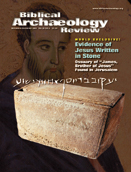JAMES’ OSSUARY—Could it be the burial box of Jesus's brother James?

According to the Baptist Press news service, July 2003:
The Israeli antiquities dealer whose discovery of the so-called James ossuary gained worldwide attention has been arrested in Jerusalem allegedly for forging the item.
Oded Golan was arrested July 21 and appeared the next day in court, where police revealed forging equipment—stencils, stones and yet-to-be-completed forgeries—they said were found in his home, according to the Associated Press.
Golan is suspected of forging both the James ossuary and another archeological find, a stone tablet with an inscription from 2 Kings 12 calling for temple repairs. Both items shook the archeological world and had scholars debating their authenticity. The James ossuary contains an inscription on the side reading, "James, son of Joseph, brother of Jesus"—leading scholars to speculate it once contained the remains of the Apostle James. It was valued at $1 to $2 million.
But both finds are now in doubt, although Golan contends they are authentic, according to the AP.
Even before Golan's arrest, the Israel Antiquities Authority said in June that both items were fakes. The scholars reached their conclusion about the James ossuary by studying the weathering process. They determined that the patina, a thin film that covers the stone and is acquired with age, had been broken, AP reported.
But in the July/August issue of Biblical Archaeology Review—where the James ossuary was first showcased—scholar Edward J. Keall says that new tests bolster the case for its authenticity. Keall serves as a senior curator at the Toronto Royal Ontario Museum, where the ossuary was displayed last year.
"The studies we conducted have convinced us that the ossuary and its inscription are genuinely ancient and not a modern forgery," he writes.
Keall argues that the weathering has “occurred at a uniform rate” and that the inscription “has weathered naturally, at the same rate as the adjacent parts of the ossuary.”
The discovery of the inscription which seems to mention James, the brother of Jesus Christ, was originally announced at a news conference in Washington, D.C. on the morning of October 21, 2002.
The inscription is in Aramaic, one of the languages of the New Testament period, and says “James, son of Joseph, brother of Jesus.” It's carved on the side of an ossuary, a box carved out of soft limestone, typically used as a bone container in the tombs of first century A.D. Jews.